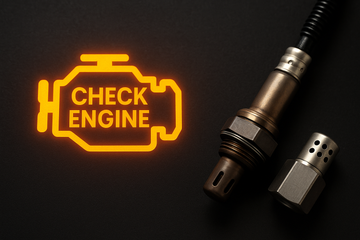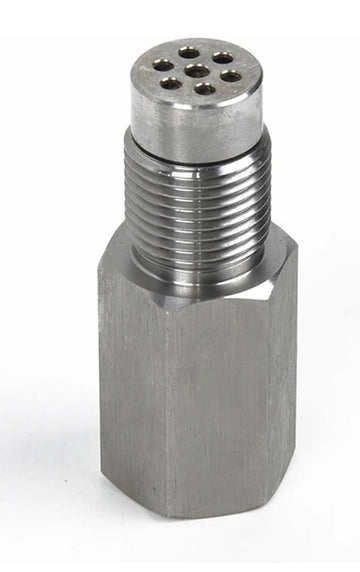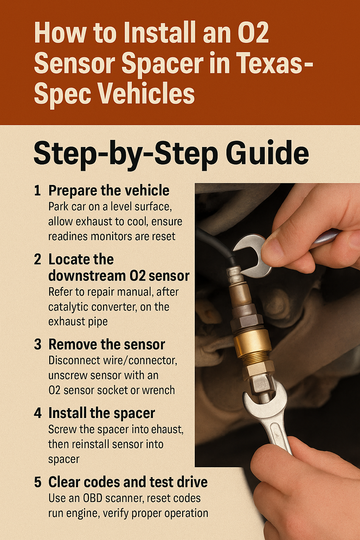Best O2 Sensor Spacers for Catalytic Converter Efficiency in 2025
Summary
O2 sensor spacers (aka O2 extender adapters or "CEL eliminators") are a popular—but controversial—aftermarket fix for catalytic converter inefficiency codes (e.g. P0420/P0430). In this 2025 buyer's guide, we'll evaluate when they are effective, highlight what specs to look for, and cover legal and performance trade-offs. Use this as a resource to choose the right spacer for your vehicle (or decide whether one makes sense at all).
Table of Contents
-
What is an O2 Sensor Spacer?
-
Why People Use O2 Spacers (and When They Can Work)
-
Top O2 Sensor Spacers to Consider in 2025 (Featuring Ghaly Motor Parts)
-
How to Choose the Right Spacer — Key Specs
-
Installation Tips & Best Practices
-
Legality, Emissions, and Ethical Considerations
-
Performance Impacts & Risks
-
Conclusion
-
FAQ: Common Questions on O2 Sensor Spacers
1. What is an O2 Sensor Spacer?
An O2 sensor spacer (also called an O₂ sensor extender, adapter, or CEL (Check Engine Light) eliminator) is a small pipe or angled fitting that sits between your exhaust bung and the oxygen sensor. The idea is to shift the sensor’s tip slightly out of the core exhaust flow so that it reads a leaner mixture (less free oxygen) and "tricks" the ECU into believing the catalytic converter is working properly.
-
The spacer changes the flow dynamics and oxygen content reaching the sensor.
-
Some spacers are straight, others are angled (45°, 90°) to place the sensor in a swirling or low-flow zone.
-
They are used predominantly on the downstream oxygen sensor (post-converter sensor) rather than the upstream O2 sensor.
Because they aim to influence the catalyst efficiency reading rather than alter fuel trim directly, spacers are seen as more of a masking tool than a performance upgrade.
2. Why People Use O2 Spacers (and When They Can Work)
Drivers often turn to O2 spacers in these scenarios:
-
Their check engine light is triggered with a P0420 / P0430 “catalyst efficiency low” code, typically when the catalytic converter is aging or failing.
-
After exhaust modifications (headers, high-flow cats, cat deletes) the downstream O2 sensor reads unexpected oxygen levels.
-
There’s a small exhaust leak upstream of the converter, causing oxygen to sneak in and skew sensor readings.
-
Thread damage or rust in the original sensor bung — the spacer acts as a “fresh” threaded section.
When they can work:
-
If the catalytic converter’s efficiency is only marginally degraded, a spacer may shift downstream O2 sensor readings back into acceptable thresholds (i.e. trick the ECU).
-
If the error is caused by minor leaks or sensor placement issues rather than a catastrophic converter failure, spacers have a higher chance of success.
But note: spacers don’t repair the converter — they only attempt to alter the sensor reading.
3. Top O₂ Sensor Spacers to Consider in 2025 (Featuring Ghaly Motor Parts)
Below are your Ghaly Motor Parts spacers — your flagship offerings — along with commentary on when each is most appropriate. These will be our “recommended” picks in the article:
-
Ghaly Motor Parts 90° O2 Oxygen Sensor Spacer / Defouler — $35.00
A 90° angled spacer designed to push the sensor out of the core flow path. Best for exhaust layouts with tight bends or where clearance is limited. The angle helps relocate the sensor into lower-flow zones, increasing the chance of altering downstream O₂ readings effectively.
View product -
Ghaly Motor Parts Universal O2 Sensor Spacer / Defouler (M18 × 1.5) — $23.99
A straight, universal spacer with the most common thread size (M18 × 1.5). Ideal when you don’t need an angle offset but just want to shift the sensor slightly downstream. This is your go-to general-purpose option.
View product
While there are other brands on the market, these two from Ghaly Motor Parts offer a strong balance of material quality, fitment flexibility, and value. Use them as your primary recommended options in this guide.
4. How to Choose the Right Spacer — Key Specs
To maximize your odds of success, inspect each spacer’s specifications in these categories:
| Spec | Importance | What to Look For |
|---|---|---|
| Thread Size / Pitch | Must match both the exhaust bung and sensor | M18 × 1.5 is very common in OBD-II vehicles |
| Length / Offset | How far it moves the sensor tip | Longer offsets push the sensor further from the flow |
| Angle / Orientation | Helps move the sensor sideways or out of the exhaust core | 45° and 90° options are valuable for tight exhaust paths |
| Material & Construction | Determines durability under heat, vibration, corrosion | 304 stainless steel, thick walls, quality welds |
| Seal Integrity | The joint must be gas-tight | Ensure sealing surfaces are clean and gaskets or tapered seats are proper |
| Temp Rating | Must handle exhaust temperatures (hundreds of °C) | Components should withstand sustained heat |
Always cross-check your vehicle’s sensor specifications and bung dimensions before ordering.
5. Installation Tips & Best Practices
A spacer can only do its job if installed properly. Here are tips to increase your success:
-
Work on a cold exhaust — Exhaust systems get very hot; work only when fully cooled.
-
Penetrating oil — Spray the existing O2 sensor threads to help loosen seized parts.
-
Use proper tools — An O2 sensor socket with side cutouts for wiring is ideal.
-
Hand-start threads — Prevent cross-threading by starting all bolts/spacers by hand.
-
Use high-temp anti-seize — Apply only to the threads, not the sensor tip.
-
Torque control — Don’t overtighten; snug is better than forcing.
-
Maintain wiring clearance — Ensure sensor wiring is away from heat/exhaust contact.
-
Clear codes & re-run drive cycles — Use an OBD-II scanner to clear existing codes and drive the car to allow the ECU to re-evaluate.
These practices help prevent leaks, sensor damage, or poor readings after installation.
6. Legality, Emissions, and Ethical Considerations
Legal Status
-
In the U.S., using devices to bypass or mask emissions controls is generally illegal under the Clean Air Act.
-
Emissions testing often includes checking OBD-II readiness monitors; a manipulated sensor reading may prevent monitors from setting or trigger failures.
-
Some states also conduct visual inspections of exhaust components; an obvious spacer may lead to automatic failure or rejection.
-
In California and other CARB-strict states, such modifications typically are disallowed unless the part has an exemption or is for off-road racing use.
Thus, while spacers may solve a check engine light temporarily, they carry significant legal risk in regulated jurisdictions.
Environmental & Ethical Impacts
-
The catalytic converter’s purpose is to reduce harmful pollutants (CO, hydrocarbons, NOₓ). By tricking the sensor, you may allow a failing cat to operate out of spec, increasing emissions.
-
Masking a real problem doesn’t fix it — you’re effectively permitting more pollution.
-
Ethically, responsible repair is to find the root cause and fix it (e.g. repair leaks, replace converter or sensors) rather than hide faults.
7. Performance Impacts & Risks
Benefits (Potential)
-
May eliminate or delay a check engine light (P0420/P0430) by altering downstream O2 readings.
-
Can help pass OBD readiness tests in some cases if the ECU sees acceptable signals.
-
Less costly than replacing a converter immediately.
Risks & Downsides
-
Unreliable success — It may work initially, but as converter degradation worsens, the spacer may fail to mask the code.
-
Heat and vibration — Poorly made spacers can crack or leak under thermal stress.
-
Code “fluttering” — Some vehicles detect O2 sensor performance inconsistencies even with spacers, causing random misfires or fluctuating codes.
-
Compromised engine tuning — In performance-tuned cars, spacers may conflict with custom fuel maps.
-
Warranty & inspection failure — If caught, a spacer may void emissions warranties or cause your car to fail official inspections.
8. Conclusion
In 2025, O2 sensor spacers remain a controversial but widely used “trick” in the performance and emissions space. While they can work in controlled cases — especially on older vehicles or marginal catalytic converters — they are not a cure for a failed catalyst. If legal risk, emissions compliance, and environmental responsibility matter, genuine repairs or replacement of failing parts is the correct path.
If you produce or sell a Ghaly Motor Parts spacer, position it in this context: premium material, tested for durability, and with clear disclaimers on legal use. Use this post as an SEO cornerstone to attract readers searching “best O2 sensor spacer,” “CEL eliminator,” “P0420 fix,” and similar keywords.
FAQ: Common Questions on O2 Sensor Spacers
Q1: Will an O2 spacer fix a broken catalytic converter?
No — spacers only attempt to mask or alter downstream O2 readings. They don’t restore catalytic function or reduce pollution.
Q2: Which sensor should I use the spacer on — upstream or downstream?
Always the downstream (post-cat) sensor. The upstream sensor affects fuel trim and engine operation; tampering with it can cause serious drivability issues.
Q3: What thread size do most cars use?
The most common is M18 × 1.5 in many OBD-II applications. But always check your own sensor and exhaust bung before buying.
Q4: Do spacers work best in straight or angled designs?
Angled (45°, 90°) designs tend to be more effective at relocating the sensor away from core flow, but straight spacers are simpler and less likely to leak.
Q5: Will the check engine light always stay off?
No — success may be temporary. Some cars may re-trigger the code as the converter degrades further or under certain drive cycles.
Q6: Is using a spacer legal?
Generally not. Many U.S. states and federal law prohibit modifications that defeat emissions controls under the Clean Air Act. Always check local laws and inspection rules before installing.


![ Fix P0420 Fast: Do O2 Sensor Spacers Really Work? [Legal Tips Inside]](http://ghalysmotorparts.com/cdn/shop/articles/ChatGPT_Image_Oct_10_2025_10_40_32_AM.png?v=1760118069&width=360)
![Do O2 Sensor Spacers Really Help Clear the P0420 Code? [Expert Guide]](http://ghalysmotorparts.com/cdn/shop/articles/ChatGPT_Image_Oct_9_2025_09_28_33_PM_654c1798-c0d4-428f-a5b6-f20b95661b54.png?v=1760129952&width=360)


